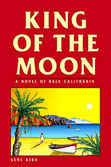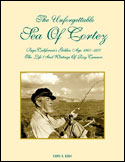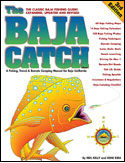Springtime kayak fishing in Baja, the next step
Mexico Fishing News, March 21, 2001
BAJA COASTAL FISHING REPORTS
ALL ARTICLES, REPORTS AND FISHING INFORMATION FOR BAJA COASTAL AREAS
Springtime Kayak Fishing -- The Next Step
By Adam "Trout" Traubman
[Editor's Note: This article is #2 of a 4-part, seasonal series on kayak fishing in Baja by Adam "Trout" Traubman. Article #1, "Winter Kayak Fishing--A Great Way to Start," can be found in the Afishinado section of this website. Trout, an expert kayak angler, is associated with Coastal Kayak Fishing (owned by Dennis Spike). CKF offers kayak fishing schools, clinics and trips for all skill levels, as well as kayak fishing accessories.
Their Web site address is: www.kayakfishing.com and they can be reached at (818) 345-5824.]
Spring. The season of growth. Growing fish. Growing skills. Everything is growing. Life continues to cast itself forward in an ongoing cyclical pattern like fresh mono rolling off the reels that we spend every winter fine-tuning. Is it next year again? Already? By the looks of my boy that came in just before the spring hatch three years ago, I'd say so. He has his pole and tackle box, not to mention a hefty number of fish caught and released in the surf. But what's more is the way he's eyeing the kayak. No pressure, no forcing I just let him go. He climbs on it. He climbs in it. He pretends to fish off of it. I'm waiting for the right time, which is a safe time, but I just don't know how much longer I can deny that look that goes along with his daily question: "We're gonna' go kayak fishin' Dad???"
Spring is the next step for all of us--the next fish, the next laugh, the next fish fry, the next beautiful spawner caught and released, the next trip to Baja, the next set of kayak fishing skills learned. With the latter in mind, I hope you can take the following information and add it to what you either know or recently learned in my winter article.
The kayak has already been outfitted with the basic gear and accessories, terminal tackle put to use, fishing tactics and techniques tested and paddling skills honed.
I've indicated that people's learning curves vary and while some may already be at the intermediate/advanced level, many may still be experiencing trouble in the surf zone, accessing hatches comfortably and landing fish with confidence. Only time on the water and taking note as to where and how the re-occurring errors take place will heighten skill level. Watch the experts in action if the opportunity presents itself and always err on asking too many questions over too few.
Springtime kayak fishing is phenomenal for a number of species and, while it serves as nothing more than a transition between winter and summer for some, I feel it's one of the sweetest times of the year. In Southern California, kayak fishing options really start to open up. Big barn door halibut slide into range, hovering ominously just above the sea floor; big bass show up ready to chew anything that crosses their path; the winter ban on rockfish lifts, renewing opportunities for big lingcod, cabezon and reds; thresher sharks, white sea bass, and early yellowtail provide the year's first "sleigh ride" and literally set the season in motion.
In Baja it's smiles all around when temperatures begin to rise and the fisheries finally release their steel, winter deadbolts. Those chilly months keep the majority of kayak anglers, including myself, sticking to the northwest region between Rosarito and San Quintin, as the rest of Baja offers mediocre kayak fishing at best. Everything changes in the spring, though, and south becomes more and more the place to be. Now, words like sierra, grouper, yellowtail, pargo, white sea bass and a slew of others turn the clickers on in the heads of those too stubborn and impatient to wait for the prized summer species like tuna and dorado to go wide open. And why not?! All are brawlers that pack more than enough power to either pull a kayak hard enough to provide a steady wake out the back, or force the kayak angler into a straight up-and-down battle where the fish conquers unless turned right out of its craggy, rock-infested domain. In addition to the big fights that these spring species put up, the fact that they're incredible on the grill or served as ceviche helps clarify why spring kayak fishing in Baja is such a dream.
Looking beyond all the positive aspects that the sport offers, there is a serious issue that must be addressed. Whether we're concentrating on Southern California or Baja, one thing that all of our fishing grounds hold in common is SPRING WIND (viento in Spanish). While I covered safety precautions in the winter article, spring wind is a safety issue requiring a segment of its own. One can fish from the kayak in a variety of conditions if equipped properly, with the exception of wind. Although fog, big swells and rain can be an issue for the kayak angler, wind is the true enemy. Our own backyards present less of a problem, as we have our local spots wired and we're familiar with weather patterns. In addition, we have the options of the inshore kelp, bays, harbors, lagoons, etc. that provide a quick escape route in the case of a sudden condition change. Being safe starts and finishes with weather radios, requesting and receiving fax and e-mail warnings and checking the Weather Channel on TV prior to a kayak fishing expedition.
Baja isn't as easy, since we aren't accustomed to the fisheries on a day-to-day basis and wind is difficult to predict on a long-term basis (most head south of the border for a week or more). Powerful offshore winds are commonplace in Baja and can be equally dangerous to onshore winds, if not worse. Onshore winds typically create sloppy conditions that help in the sense that they deter kayak anglers from ever going out in the first place. Nothing is more unappealing than fishing with whitecaps sloshing over the deck. On the contrary, the smooth sea surface that accompanies offshore wind is like the beckoning call of the mythical Sirens that led tempted sailors to their doom. Offshore winds have the ability to take a kayak angler miles out to sea, before he or she realizes the situation at hand and the best way to avoid this situation is to stay away from it altogether. Study the water prior to fishing and use good judgment. There's a great chance both locally and south of the border that kayak anglers can find days on end where conditions are conducive to good fishing. When the tides, weather, and bite all cooperate, it's only a matter of getting out there paying some dues.
One phenomenon that really stands out in spring is the spawn. What a miracle! Bizarre rituals, strange behavior and adjustments in otherwise normal patterns are all part of the puzzle in the reproduction process. Since this can be taken into a whole separate tangent, I'll simply explain what this has to do with kayak fishing: (1) Big fish move in tighter to shore to spawn and this inshore zone is easily accessed by kayak (2) These big fish sometimes travel long distances without eating much and are ready to feed (3) The hatch that occurs starts a reaction in the food chain hierarchy, from bait fish to the biggest, and by combining the proper bait with the proper presentation, a kayak angler can target any species within range.
Going back to the proper bait, a lot of people throw around the term: "match the hatch." This is a multi-faceted phrase. For some anglers like freshwater fly-fishermen, this refers to bugs or insects that have just hatched and are #1 on the targeted specie's menu. For anglers that fish the salt, the phrase can refer to the eggs or newborn fry swimming about. Unlike freshwater, the saltwater hatch is not always the ideal bait to mimic. Matching the hatch would mean finding minuscule (if not microscopic) baits, which certainly isn't any fun for the angler. When targeting medium to large fish, avoid baits and lures under three inches in length, with the exception of cut bait.
The spring spawn in our local saltwater fisheries brings out true prehistoric aggression and volatility in the fish, which is brought on by an innate drive to defend their offspring. With that in mind, better results can be found in matching the predators that are prone to invade a mother's eggs or school of fry and this is where we as kayak anglers get our edge. Easy access to the spawning grounds with minimal sound and no fuel emissions awards us with the ultimate approach to springtime kayak fishing, especially since the fish are hypersensitive to intrusions. With the big spawners displaying such antagonistic behavior in defense of the eggs or fry, even the wrong baits can induce the big fish to bite. Fish will even bump or strike at flashers, swivels, bare hooks and especially lead weights that infringe upon the nursery, let alone the bait presentation, and this "reaction bite" is yet another advantage for the angler.
Ideal live baits are in the 4"-8" range and include: mackerel, sardines, smelt and perch, among others. Artificials typically range from 3"-6" with some trolling baits like Rapalas going a bit longer. In addition to the baits mentioned above, other predators that commonly ambush eggs and/or schools of fry are: crabs, lobsters, urchins and other crustaceans/shellfish.
The spring spawn also means that structure is more sought after than ever, and many feel that it is the absolute foundation for finding and catching fish. In regard to kayak fishing that's fine by us! Stealth moves go hand in hand with a kayak, and maximum maneuverability further enhances this optimum approach to targeting, catching and landing fish in a variety of structure. Kayaks sashay through the thickest of kelp paddies, which hold prime, inshore species. They pull tighter to the boiler rocks than any motorized vessel. They murmur through the shallow flats without disrupting a thing. In essence, kayak anglers have the ability to use structure to their advantage more so than any other motorized vessel--so how do we find it?
As the kayak fishing skills progress, more gear can be accommodated, including sonar. Commonly known as "fish finders," these tools are indispensable when it comes to locating structure. Although the kelp paddies and boiler rocks are hard to miss, underwater rock piles, drop-offs, deep pockets, short kelp stringers, over-hangs and more are common spawning zones that provide shelter and camouflage for unsuspecting schools of fry and inert mountains of eggs.
Springtime kayak fishing may be a bit more hit and miss than the season running from early summer to late fall, but it certainly provides enough action and incredible wildlife to keep us all out there. Contrary to the summer-time flurries of bag limits regardless of bait, technique and approach, the spring style of kayak fishing is both thought provoking and challenging, much to the likes of Spy vs. Spy. Hard work and persistence will procure multiple big fish catches far before others ever take their gear out of storage. The fact that we get the opportunity to encounter migrating whales, frolicking dolphins and other marine life in addition to the sensation of fishing from the kayaks renders the sport untouchable.
By spring's end, you should have caught some beautiful species from the kayak and encountered a wide variety of marine life, while battling a few spring gusts along the way. Skills will be sharpened during this time and all for a good reason--summer. Prime time awaits and in article #3 of this 4-season piece, I will essentially cover how to deal with bliss. In regard to kayak fishing, what do you do when you encounter a totally wide-open bite? What do you do when you catch a fish over 20-pounds, or over 100-pounds for that matter? How do you deal with blood after gaffing a fish? How can you use Motherships to get to the "real" fishing grounds? And my favorite--how much sashimi will my little kayak bring me? These questions and more will be specifically addressed in the summer article.
COMING NEXT: SUMMER KAYAK FISHING!
BAJA CALIFORNIA, MEXICO: LAGUNA TOURS, Guerrero Negro, March 21, 2001, Whale Watching Tours, Doris. Hola Gene. We still have many whales in the lagoon. They estimate close to 900. That is a good number considering we are towards the end of March. The weather has been good here. We have hit a record with people touching whales this year. Since the last time I wrote, everyday the people have touched them. We are very happy because the people leave happy and when they are happy so are we. Looks like there might be some whales still in early April. Doris.
In other mainland Mexico and Baja fishing action this week:
MAGDALENA BAY FISHING REPORTS
ALL ARTICLES, REPORTS AND FISHING INFORMATION FOR MAGDALENA BAY
MAGDALENA BAY, MEXICO: BAJA ON THE FLY, San Carlos, March 21, 2001, Gary Graham, Reservations Tel 800-919-2252; Fax 760-746-7260. Temperatures: 75-degree high; low 59"
TUNA--Pretty quiet"
YELLOWTAIL--Entrada (the entrance) is still the best bet"
CORVINA--Few reported this week up toward Devil's Curve"
SNOOK--Slow going this week with only a few anglers out"HALIBUT--Continue to be the best bet for the fly rodder.
QUICK COMMENT--You have several choices: head out to the entrada and try your luck with the yellowtail or head into the mangroves and catch plenty of bay bass, halibut and maybe a snook or two.
CABO SAN LUCAS FISHING REPORTS
ALL ARTICLES, REPORTS AND FISHING INFORMATION FOR CABO SAN LUCAS
CABO SAN LUCAS, MEXICO: PICANTE FLEET, Cabo San Lucas, March 21, 2001, Sergio Cortes, Reservations Tel 011-52-114-32474; Fax 011-52-114-35969. Fish available: Striped Marlin, Swordfish, Yellowfin Tuna & Sierra. Water temperature: 69-72.5. Air temperature: 87/53. Humidity: 41%. Wind: 8-10 Knots (Pacific), 8-10 Knots (Sea of Cortes). Fleet production (5 boats): 2 Striped Marlin, 1 Swordfish & 32 Tuna. Hot spots: Gordo Banks. Luckiest boat: Picante Express (31' CABO). Captain: Jaime "Hook" Gonzalez. Angler: Mark Lawrence. Production: Swordfish 170 lbs. & 3 Tuna 20-30 lbs.
Water temperature is warming up and Striped Marlin fishing is improving. Yellowfin Tuna has been averaging 30-45 lbs. in good numbers. Lots of Sierra (Spanish Mackerel) closer to shore. Some Swordfish have been spotted also. Sunny days and moderate winds in the afternoon.
CABO SAN LUCAS, MEXICO: FLY HOOKER SPORT FISHING, Cabo San Lucas, March 18, 2001, Capt. George & Mary Landrum, Reservations Tel 011-52-117-01271; 011-52-114-87452. WEATHER: Let me start right off by saying that this week was almost a repeat of the prior week and the week before that as far as the wind was concerned. We had steady breezes and gusty conditions coming from the northwest all week, with the winds really getting into high gear starting Thursday evening. Daytime temperatures were in the very comfortable 75-85 degree range with evenings dropping to the low 60s.
WATER: Due to the windy conditions very few boats went beyond the lighthouse on the Pacific side. Near shore up to the lighthouse was in the lee of the wind but the water was still choppy. Outside of the Arches and up the Sea of Cortex for several miles it was a bit rough most afternoons but the further up north you got, the better the conditions. By the time most boats got to the area off the Westin Resort the water was in great shape. All the wind forced down and held cool water to the shore on the Pacific side of the cape and the near shore temperatures were in the mid to low 60s. The temperature charts showed that San Jaime and Golden Gate Banks were several degrees warmer but there was no one fishing them that I was aware of. We did have e nice warmer water just outside of Cabo on the Cortez side, and this warmer water extended along shore out to about three miles until outside of north San Jose. There it expanded and there was no cool water outside the three-mile area, it was all the same. By warm water I mean water in the 69-70 degree range. Out towards the Cabrillo Seamount there was a large area where a warm water eddy had bands of 71 and 70-degree water circulating.
BAIT: Lots of Caballito but not much Mackerel were available this week from the local bait boats. The usual price of $2 each was in effect. There were sardinas available up in San Jose and if you were there early you had a good chance of getting a good load. They were running about $20 for enough to last the day.
BILLFISH: Ok, this past week we started to see a few more Striped Marlin than in the past week, and they were biting a little better. It seems that instead of one Blue flag for every 10-15 boats we were seeing three or four flags for the same number. This is still by no means a good bite, but it is a definite improvement. The fish that were caught were mostly caught on live bait, tossed to them when they were found tailing on the surface. About 35% of them were caught on lures.
YELLOWFIN TUNA: Without a doubt these fish were the bright spot for the week, at least for the boats willing to make the run and spend the fuel to reach Gordo Banks. The warmer water resulted in the reappearance of Sardinas in the area and it seems as if this also cleared the green water and brought in the Tuna. Most of the fish at the Gordo Banks were found on the Inner Banks and they were averaging 20-25 pounds. Once in a while a group of 35 pound fish would cruise through and there were the occasional 60-85 pound fish hooked up, with a few of them brought to the boat. With all the activity in the area after the word got out, the Yellowfin started to get a bit line shy and most of the boats were running hooks with no leader, instead tying the hooks directly to 20-40 pound test line. Live Sardinas were the way to go and mixing drift techniques with slow trolling constantly produced action. There were also reports of Yellowfin Tuna coming from Dolphin Pods located 40-50 miles out, mostly to the southeast. Some boats reported catching 20-25 fish within an hour or so. These fish were traveling through the area and there was no real consistency to the action out there.
DORADO: Definitely hit and miss on these great fighting and great eating fish. There were a few caught but there was no consistency to the action. It may be due to the cold water that the winds brought in, but I don't think we are going to be seeing any concentrations of Dorado for a while yet.
WAHOO: Better to say "What Hoo?" Sorry Jeff!
INSHORE: Some boats are reporting hot action for large Snapper off the rock piles near shore and I have seen some of these catches come in. They are using the large live Caballito as bait and getting right into the rocks with them. I guess that if you are experienced and know what you are doing that they are there to be caught, I just never have much luck on them myself. I have also heard that there are quite a few Yellowtail being taken off of the Arches in the morning. Many of these fish are in the 20-pound range. Jigging iron in green/silver and blue/silver seems to be the key to many of the fish and some anglers are reporting white/scrambled eggs to be working well. These fish are being found down about 120 feet in 180 to 200 feet of water. Not so many Sierra as there were a few weeks past and the size of the Roosterfish is down. Most of the roosters are running about 5 pounds with a few in the 20-pound range being caught. There have been plenty of Skipjack to be found and they are keeping many anglers happy with the excellent fight they put up, if not for the taste on the table.
ONSHORE: Hey, its Spring Break!
Well, that's all until next week folks! I have my fingers crossed that the Yellowfin bite stays good and that the Marlin bite improves. Guess that we will just have to wait and see. Until then, "Tight Lines"!
CABO SAN LUCAS, MEXICO: PISCES FLEET, Cabo San Lucas, March 20, 2001, Tracy Ehrenberg, Reservations Tel 011-52-114-31288; Fax 011-52-114-30588. BILLFISH: We are still going through our March "doldrums", with not a lot of marlin action, not everything was gloomy though. The highlight of the week was a beautiful 200 lb swordfish caught aboard "Tracy Ann" on Sunday, March 18th, by Gordon Bennett, from Scotch Plains, New Jersey. They discovered the fish dozing on the surface 4 miles out from the 95 spot, in 70-degree water. The broadbill took a live mackerel and took 3 hours and 20 minutes to boat on 40 lb test line. The marlin rates were even lower this week than last period with only about fifteen percent hooking up to stripers. A welcome change has been a couple of days of uninterrupted sunshine and regular Cabo weather--which we haven't seen in a couple of months. Our overall catch success rate for all species combined was a low sixty-three percent. It seems that the season is a little ahead of itself, we should have been seeing the slow fishing right around Easter, with lots of yellowfin tuna catches, starting in April, but it looks like we are already going through this. Pisces anglers caught a total of 6 striped marlin, with all but one released and one swordfish.
OTHER SPECIES: Yellowfin tuna were very welcome catches this past week, with the marlin fishing so slow, boats caught tuna throughout most of the week, with a couple of big schools found, one off of Palmilla on the Cortez side and the other at San Jaime, on the Pacific. Weights ranged from 15 to 80 lbs, with boats averaging from 4 to 14 per boat. Most of the other small game fish was inshore, again there were plenty of sierra, red snapper and amberjack, with the odd skipjack here and there; found at the Old Lighthouse and Palmilla.
LOCATION: Punta Gorda, Red Hill, Chileno, San Jaime, And Old Lighthouse. WEATHER CONDITIONS: Skies partly cloudy, with a couple of beautiful sunny days at the end of the week, seas are nice. AVERAGE WATER TEMP: 69 F. BEST LURES: Live bait, assorted feathers.
CABO SAN LUCAS, MEXICO: REEL EASY SPORTFISHING, Cabo San Lucas, March 17, 2001, Mike & Renee Hebert, Reservations/Fax 011-52-114-33579. Captain Alvaro Gastelum of the Sea u Later and Captain Tony Gutierrez of the El Chilito reported up and down days for fishing. Cool water and rough seas had the Marlin a little further out than most anglers like to venture. By week's end however, the Stripers were turning up a little closer to shore. During the slow down in the Marlin bite, anglers took to the closer to shore fishing for some fast action with the light tackle and the smaller game fish. Totals for the two week period were 45 Yellowfin Tuna, all on lures, 2 Striped Marlin, both released, 1 Yellowtail, 9 skipjack, 25 Barriletes, 45 Sierra and 1 Rooster fish.
CABO SAN LUCAS, MEXICO: JEFF KLASSEN SPORT FISHING, Cabo San Lucas, March 15, 2001, Jeff Klassen, Reservations Tel 360-402-3474. Here's the big news folks, the first annual Surf & Panga Roosterfish Klassic Tournament is now a go! The permits and licenses have been taken care of, we've got the backing from the Mexican Tourist Office, the IGFA and plenty of sponsors so finally, after all these years of planning, it's a go. It will take place July 05, 06 and 07 in Cabo San Lucas and will be limited this first year to 60 anglers, involving 1.5 days panga-fishing and 1.5 days surf-fishing. Check out all the information, rules etc on the special tournament page at http://www.jeffklassenfishing.com/cabotourney.htm. We already have about 20 anglers signed up so anyone interested better hurry, as space is very limited.
Offshore fishing has really taken a turn for the worse this past week or two, with water temps dropping to as low as 63 degrees (averaging 68) in areas and seemingly going on forever. Once again, I am pointing out that this is somewhat normal for this time of year. Fishing in March is never spectacular here.
While most boats still concentrated their efforts along the Pacific-side, particularly around the old lighthouse, several others found the 70 degree thermo-cline along the gulf side. These spots were primarily along the stretch of coast between Cabesa Ballena and the Westin and no more than 500 yards or so off shore. Quite simply put, most boats missed this area completely, opting to go way offshore, as much as 40 miles or more in search of warmer water. This temperature break caused all kinds of commotion around it as a number of species including marlin, dorado, tuna, sierra mackerel, wahoo and even yellowtail were vying for it. Other than this area though, the offshore fishery remained somewhat flaccid, with boats being limited to spotty catches of smaller dorado and schooling Yellowfin tuna between 10 and 20 pounds.
Inshore fishing, however, has been pretty damn good lately. There are as many sierra around as one would want, particularly along the Pacific-side beaches, from Playa Grande all the way up to Rancho Migrino. Use CD-7 Rapalas and just about any colored Sierra Slayer or hootchie for them. Pargo are still being frequently encountered not only amongst the rockier points but also in schools along the sandy beaches, in the late afternoons. Larry Lowman and party bagged 14 of them a few days ago right off of Playa Grande. Live or chunk bait will work cast in to the rocks with heavy gear but be careful backing a boat in, as we've already had our first wreck and apparent fatality of the year, while fishing this way. Creep up slowly on the schools of pargo, encountered away from the rocks, and cast a Klassic Popper or Ranger at them.
The yellowtail bite has improved and they are now readily available. Yo-yoing irons all around Lands End or trolling live-bait around the rocky points will work for you. There are also still good quantities of roosterfish near shore, with fish up to 25 pounds. Brad and Teresa Dong were fishing the Juanita V and landed 8 of 10 they hooked up, to go along with their dorado, which they bagged earlier in the day. Fly-fishermen note that there are tons of skipjack around too, which will keep you busy.
Surf-fishing continues to get better as we move along. Lots of Sierra macs on both sides on Krocodile spoons and short wire leaders. They're not real big, with most fish being about 4 to 5 pounds but there are plenty of them. The Pacific-side beaches, from the Pedregal on up have quite a few Roosterfish along them. Use the usual top-waters I always go on about. There are good numbers of large jacks up past Playita still, just hanging around between La Laguna and Gorda Point. Two 25 poundish snook were again caught near the Hotel Presidente and slightly north, away from the estuary. Both were caught on spoons. Don't forget to fish all of the rocky areas from Smengy Point all the way up the corridor. I've been told by several panga operators that they've seen schools of some kind of fish finning around outside rocks. These are Bigeye trevally and they'll hit poppers, just like the jacks.
CABO SAN LUCAS, MEXICO: BAJA ANGLERS, Cabo San Lucas, March 21, 2001, Grant Hartman, Reservations 888-588-3446. The inshore action has been the story over the last few weeks. The sierra action has been hot over the last few weeks, but started slowing down a bit a few days before this report. Dan Dreyer a businessman from Arizona had some outstanding fishing. Over 2 days he caught over 100 sierra on the fly. It was non-stop action for over 8 hours. Some of these fish went well over 10-lbs. If you haven't caught a sierra before , they are a great speedsters that remind me of a mini wahoo. Pound for pound they outfight a bonefish when taken on a 8 wt. outfit. The bigeye travelle are giving us some fun action on the Sea of Cortez side.
Large Jack Crevalle are located on both the Sea of Cortez and pacific side in good numbers, but most fish are daisy chaining. When circled up they are hard to catch. This daisy chain is a natural reproduction process. No wonder they aren't interested in eating. Cubera Snapper are abundant right now, also the fish are holding right in the rocks next to shore. Hooking them isn't a problem, getting them out of the rocks is. Amberjack and yellowtails in the 15 to 40-lb range are holding deep off the points around Cabo. Catching a 2-6 a day on jigs is the norm right now. Nothing tasted better than a well prepared amberjack or yellowtail.
Offshore fishing continues to be slow for striped marlin. The only saving grace is the exceptional tuna bite over the last few days. The Yellowfin Tuna moved back onto the Gordo banks making for some hot action. These fish are running around 20-40-lbs. Most boats were catching 10-20 fish day.
The weather has been a bit on the windy side, making for choppy seas on the pacific side, but the Sea of Cortez side is the lea of the wind and perfectly flat. For those of you that want to try our great spring fishing for BIG roosterfish, jacks, snapper, sierra, and other inshore species, better book now. My April, May, and June months are almost booked up. Half of May and the beginning of June are reserved by last year's anglers alone.
SAN JOSE DEL CABO (LOS CABOS) FISHING REPORTS
ALL ARTICLES, REPORTS AND FISHING INFORMATION FOR SAN JOSE DEL CABO
SAN JOSE DEL CABO, MEXICO: GORDO BANKS PANGAS, San Jose del Cabo, March 17, 2001, Eric Brictson, Reservations 800-408-1199; Fax 619-447-4098; 011-52-114-21147. With the start of springtime just around the corner crowds of tourists have increased and though the unpredictable weather patterns continued this past week there were finally a couple of days where the high temperatures reached into the 80s. The wind could not decide which direction to come from, one day it would blow out of the north, then the next day it would be out of the south, then on the following day there would be no wind at all to speak of. While other areas of Southern Baja found only minimal action, the anglers fishing out of San Jose del Cabo, and especially from the panga fleets, had great fishing for yellowfin tuna, as the bite that had slowed almost to a standstill the previous week picked up where it had left off. Supplies of live sardinas remained steady but with the increased crowds it meant that you did need patience to wait in line for your daily supply. It was definitely worth waiting for the live bait because that is what about 90% of the action was taken on.
Yellowfin tuna were hitting the live bait in the areas of the Gordo Banks and north to Iman Bank. The most consistent spot was on the Inner Gordo Bank where average catches ranged anywhere from 2 to 12 tuna per day. Most of the fish weighed 15 to 20 pounds but everyday there were larger tuna caught, including fish in the 70 and 80 pound class. With the lack of billfish and dorado action offshore that has meant that there was more pressure put on by the cruiser fleet, fishing in the same areas as the pangas and this caused the fish to become a bit more line shy than they had been. Anglers using 20 to 30 pound tackle had the highest percentage of hook-ups but when the larger tuna were hooked there was not much of a chance landing them on the light gear. So it was wise to have the 40 and 50 equipment ready to go for when the larger fish did come up. One of the main factors for the improved bite was that the water cleared up substantially, though the temperature was averaging a cool 66 to 69 degrees.
Other action included a mix of bottomfish like amberjack, pargo, cabrilla and several nice yellowtail. These were mostly hooked by working iron yo-yo style jigs off of the rock piles. There were also more than enough black skipjack around and at times they proved to be a nuisance when trying to catch the yellowfin tuna. Along the shoreline from Red Hill to Punta Gorda anglers found good action for smaller game fish like sierra, pargo and roosterfish. Large schools of bait fish are moving into the area of La Playita and this should attract more game fish. The roosterfish being caught now are mostly juvenile fish under ten pounds but the big ones should follow soon. Important note also is to remember to insist to your skipper that you do want to release all of the roosterfish that you hook in order to give them a chance to grow to maturity and insure the future stocks.
EAST CAPE FISHING REPORTS
ALL ARTICLES, REPORTS AND FISHING INFORMATION FOR EAST CAPE
EAST CAPE, MEXICO: BAJA ON THE FLY, Buena Vista, March 21, 2001, Gary Graham, Reservations Tel 800-919-2252; Fax 760-746-7260. TEMPERATURES: High of 84 with a low of 54. STRIPED MARLIN--Slow. YELLOWFIN TUNA--Still a long run to get to them. DORADO--A few dorado throughout the bay. ROOSTERFISH--Mostly smaller fish close to shore. JACK CREVALLE--A few small fish are hanging in front of the hotels. BARRILLETE OR MEXICAN SKIPJACK--Fair catches below Los Frailes. PARGO AND CABRILLA--Good near shore at Punta Colorada or Cerro Verde. OFFSHORE: While the water seems to be warming up slowly, unfortunately the best offshore action is still several hours away. INSHORE: Small jacks and sierra continue to provide fair action close to shore. BEACH: A few small roosters and jacks early morning and late afternoon.
QUICK COMMENT--While not wide open, we are finding a few skipjack and tuna a couple of hours from the hotels. And recent visitor Dr. Karl R. Beutner, from Vallejo, Calif., wrote, "We had a great time fishing three days with light to moderate action on tuna, sierra, dorado, white bonito, roosters and a few pargo."
Yvonne (who broke her foot during the San Mateo show) is sporting a new walking cast and we are headed for Phoenix for the International Sportsman's Expo beginning Thurs., March 22. I will be presenting my Baja on the Fly program 5 p.m. Thurs.; 2 p.m. Fri., 23; and 11 a.m. Sun., 25. Stop by and say hello if you attend the show.
EAST CAPE, MEXICO: EL CARDONAL'S HIDEAWAY, El Cardonal, March 21, 2001, Eddy, Reservations 011-52-114-10040. The water is warming up. Lots of pargo in front of El Cardonal. Some days the commercials haul up to 400 kilos at Punta Perico and Punta Arena. There are some tuna. Lot of bareletty and bonito (we have a new name for these two last type of tuna: "black fin tuna" if you bleed them right away there are great in chunks in a cooked tomato, ognion, green pepper, garlic, white wine, cream and butter sauce. Some sierra on the fly. Now at el cardonal we have 2 new kayaks for fishing. Lots of small and medium cabrilla from shore on a fly. We promote catch and release for all species. Fish and have fun. Don't kill just to kill.
EAST CAPE, MEXICO: RANCHO BUENA VISTA, Buena Vista, March 21, 2001, Tamara Moyeous, Reservations 800-258-8200. Not a lot of fish caught, but not a lot of guests either. A total of 116 fish were caught between Mar 02, and Mar 16. Ten dorado, 1 tuna, 29 barilete, 25 jurel, 10 cabrilla, 43 pargo. We are picking up and should start with better fishing soon!!! Best, Tami.
EAST CAPE, MEXICO: RANCHO LEONERO, Bahia de Palmas, March 18, 2001, John Ireland and Roy Baldwin, Reservations 800-646-2252; Hotel 011-52-114-10216. Continued mild spring weather, with daytime highs in the upper 70s, cool evenings in the mid 50s, partly cloudy skies, calm mornings with breezy afternoons and water temp 65-67. Light fishing pressure with few fishermen this past week, despite the improving conditions. The catch continues to be mostly inshore, with sierra, skipjack and amberjack providing most of the action. Midweek saw our first yellowfin tuna of the season, with fish to 25 lbs taking mostly live bait. With lots of mackerel in the water, the fish remain line shy and lighter tackle was producing better. Plenty of tailing striped marlin continue to be sighted, but few showed interest in biting--watch this to change as the water begins to warm.
EAST CAPE, MEXICO: HOTELS PALMAS DE CORTEZ, PLAYA DEL SOL, PUNTA COLORADA, East Cape, March 18, 2001, reported by Dave "Smokey" Manuel, East Cape Smokehouse, Hotel Reservations, 800-368-4334. I'd be lying to you if I said we're off to a great start down here. We're not. We just can't seem to get the water temps out of the mid sixties and until that happens, things probably won't change much. I've been getting readings consistently running 64 to 67 degrees for weeks from off shore and yesterday finally took a surface temp of 68.4 standing on shore. To give you an idea of how that compares to the last two years when we had some excellent early fishing on Marlin and Dorado, both years during those same dates temps were running 69-72 and the 5 degree difference seems to have quite an effect. The good news is the frequency of windy days from the North are dwindling and day time temps are climbing, so perhaps with an ocean current bringing in some warm water, we'll see the water temps back into the low 70s soon to give numbers a boost. The past weekend the best news came from the North near Muertos Bay. Just off of Punta Perico outside the bay, a few charters found a good Yellowtail bite using Sardines. That locale has sputtered the past week with a good bite one day and nothing the next, but Saturday it was producing again, with most fish taken in the 8 to 15 lb class. These are Yellowtail, not Yellowfin Tuna and are not uncommon in the cooler water temp range. Also a few local anglers and one charter Captain reported some good bottom fishing on Pargo just North of Los Barriles off the "slides" this weekend. And believe it or not, that's about it. Live bait supply has been good off Los Barriles on Mackerel for weeks, but the Sardines have been difficult to find nearby.
EAST CAPE, MEXICO: MARTIN VERDUGO'S BEACH RESORT, Los Barriles, March 20, 2001, Marisol George, Reservations 011-52-114-10054. Hello Gene. Nothing new Now is quiet, no fish, the water still cold and we are waiting for the fishermen. Alma.
LA PAZ FISHING REPORTS
ALL ARTICLES, REPORTS AND FISHING INFORMATION FOR LA PAZ
LA PAZ, MEXICO: JONATHAN ROLDAN'S TAILHUNTER ADVENTURE SERVICES, La Paz, March 19, 2001, Jonathan Roldan, Tel 626-333-3355; Fax 626-333-0115; Pager 323-349-8111; Message Pager 877-310-7734. I was beginning to think we were finally settled into the "care package" fishing for this time of year. You know. . .open the fish box on the panga and there's a few tuna, some cabrilla, maybe a pargo and a yellowtail and some sierra. Good fun fishing with a mixed bag of fillets for the freezer. Then all of a sudden, WHAM! That school of yellowtail that had gone to ground two weeks ago and really made our January and February made a prime time appearance off Punta Perrico. One of my pangas got limits of 12 to 20 pound forktails not far off the point on live bait and estimated they had another 20 released! They switched to lighter line and stopped counting all the breakoffs! Other boats didn't do much differently either.
Yellowfin tuna are still at the mouth of Muertos, but the bigger fish are podded up at South Point at Cerralvo Island. These aren't the toads we've had in the past, but certainly a respectable 35 pound fish is to be had. It's really a nice time to fish. Skies are generally blue and air temps are about 75 degrees with just a slight NW breeze which doesn't have much effect at all. Bring a windbreaker for the morning, but by 8 a.m. you're down to t-shirts. Best of all, with so few pangas out, it's almost like having the honey hole all to yourself! A few of the boats have made it to Pili up the east side of Cerralvo and the pargo are showing more of a willingness to chew. Of course, if you've fished pargo before, that might not be saying much, but the fish are boiling around the boats. One boat also pulled off the inshore bite and saw some nervous water outside where about twice a year we have a rodeo of 60 pound tuna show up. It's only about 300 yards offshore and there must be a high spot there. Anyway, this boat slow trolled a sardine through the area and got hammered on something that they fought for about 30 minutes before farming the fish. Never saw it and never got to color. They only told me that they had to fire up the panga to chase down the fish to keep from being spooled! Could be a pretext for the tuna showing up there sometime soon! We'll keep ya posted!
By the way, for your calendars:
April 17-21--Have a spot for one more person for our pargo, cabrilla, yellowtail school. 5 days/4 nights/3 days panga fishing/all meals/taxes/hotel tips/ground transfers. I'll make ya a helluva deal to fill the spot! You can literally fish 24 hours on this trip. Personal instruction from me if you want. Great fun group.
August 22-26--Sitka, Alaska! Fish the big halibut and salmon plus go for rockfish, clams and crabs! 5 days/4 nights/3 days fishing (10 hour days)/hotel/all meals/1st box of fish processed/all tackle and bait. $1600. You won 't find a better deal!
Finally. . .dates in La Paz are filling up quickly. Just an FYI. We'll be down most of the season as usual but airline seats might be scarce if you haven't already locked some dates and some of the hotels in town are already filling up for the fishing season!
Let us know! Thanks! Cheers to ya all! We'll be in Phoenix for the ISE show this week. Come by our booth!
LA PAZ, MEXICO: PIRATES FLEET, La Paz, Francisco Aguilar, March 21, 2001, Reservations, Reservations/Fax 011-52-112-57353. Hola amigo. Good yellowtail biting at the south end of Cerralvo and also small size yellowfin tunas. Good pargo catch and lots of bait around. Francisco.
LA PAZ, MEXICO: HOTEL LAS ARENAS, Punta Arena de la Ventana, March 14, 2001, Linda Glassman-Davis, Reservations 888-644-7376. Captain's: Efren, Luciano, Roman, Daniel, Manuel, Salador, Guicho, Fidel and Jorge. Fish count: Sierra 13 to 5 lbs., Cabrilla 14 to 9 lbs.; Pargo 8 to 4 lbs.; Yellowtail 9 to 32 lbs.; Bonita 6 to 5 lbs.; Yellowfin Tuna 25 to 55 lbs.; Dorado 3 to 22 lbs. The weather is calm. The water is warming up and the fishing is great! Come down and see us during our 4th Night Free promotion.
LORETO FISHING REPORTS
ALL ARTICLES, REPORTS AND FISHING INFORMATION FOR LORETO
LORETO, MEXICO: VILLAS DE LORETO, Loreto, March 20, 2001, Wendy Wilchynski, Reservations Tel/Fax 011-52-113-50586. The weather is great! The fishing is good and we are busy, what more can I say? Wendy.
LORETO, MEXICO: EL FUERTE SPORT FISHING, Puerto Escondido, March 21, 2001, Ty Miller, Reservations Tel 714-775-6658; Fax: 714-755-3501; Loreto 011-52-113-30863. Hola Amigos. Yellowtail in the 25 to 30 pound class have been found out at our favorite fishing spots at Isla Catalan, but they still are not in the big quantities that we would expect this time of year. The fish are still on the move. For example: one day they popped up at Fish Camp and the next day they showed at the Slide area.
Smorgasbord Reef is still holding quality size yellowtail, but the bite has been kinda "hit and miss" lately. Captain Juanita did hang a 30 lb. yellow on the iron there, though. So, that could mean they are starting to be more aggressive. Hope this is a turn for the better so we can start hanging more fish on the iron.
The Bump outside the harbor has been producing perfect size bigeye (Caballitos) for bait and can be found biting between 6 a.m. and 7 a.m.
So, it's a little up and down on the fish count lately but that can change tomorrow. We have plenty of fishermen coming down to stay on top of things and with the awesome weather we are having, we are due!
Air Temp: 84. Water: 67. Winds: Light. Seastate: Flat.
LORETO, MEXICO: BAJA BIG FISH COMPANY, Loreto, March 21, 2001, Pam Bolles, Reservations Tel/Fax 011-52-113-50448. It's just starting to get better and better. The winds have been up for the last few days but the air from them is warm so they're not true nortes, just transition winds. We're also getting south winds which is good news for the water heating up. I would guess that about 80% of the yellowtail are still actively spawning, the rest are actively feeding. As the days pass, more and more will feed.
Yellowtail: You're going to love this....we're getting very large Yellowtail in the 40+ pound class off Punta Pulpito, way to the north. To the east off Isla Carmen, we're getting yellowtail slightly smaller, in the 35 pound class, and off La Cholla more 30+ pounders! It seems as if the fish are in every direction, and they're all on the surface. But don't jump on that plane just yet...it will take at least another week for all of the fish to come off the spawning cycle and feed voraciously. And they will do just that! Most of them are still actively spawning and aren't feeding. This fact, coupled with the winds will make fishing a challenge. Yes a few boats will get fish, but most will get skunked--so just have patience. It'll happen very soon! Other Species: Now that the moon is darkening again, count on catching more Cabrilla (seabass species), in all sizes (from 1-20+ pounds). Trolled rapalas, yo-zuris, rebels, etc., over the reefs off the islands and northern locations will produce quality fish. You will also pick up large (10-15 pounds) barred Pargo by trolling similar lures over structure. There are lots of true red snapper, or huachinango probably as a result of all the bottom fishing that's taken place in lieu of going for yellowtail. Bait: The bait sellers are showing up infrequently so make sure you have that Lucky Joe rigged up and ready.
BAHIA DE LOS ANGELES (L.A. BAY) FISHING REPORTS
ALL ARTICLES, REPORTS AND FISHING INFORMATION FOR BAHIA DE LOS ANGELES
BAHIA DE LOS ANGELES, MEXICO: CAMP GECKO, Bahia de los Angeles, March 21, 2001, Abraham Vazquez, Tel 011-52-515-19454; Fax 011-52-665-03206 (goes to Guillermo's). Air temp 82-58. Winds mild out of the west to no wind at all. Humidity 50%. Seas calm. Water temperature still cold but starting to rise 61-58. Fishing very average for this time of the year plenty of bottom fish, some nice baqueta, and a few yellowtail caught this week. The yellows have not been too big 10 to 15 lb, but for this time of the year that is good, caught on jigs over boils, at Guadalupe reef and at Don Juan point also some by Coronadito. I will try to attach a couple of pictures to the report. Road conditions good for most of it. Beware of km 9 to 10 , gasoline 130.00 for 5 gallons. Town has been slow , not many people yet but everybody is getting ready for spring break. Villa Vitta Hotel closed it's doors last week. There is a project to turn the bay into a national marine park much like Loreto and so far everybody is in favor of this. I think it will be our way of keeping on eye on the escalera nautica (which by the way does not exist yet) and every other "mega project ", that gets thrown our way . I will try to send this report via e-mail see if it works, if it does I might be getting online soon, finally.
LA PAZ PANGA MOTHERSHIP FISHING REPORT
SAN FELIPE, MEXICO: TONY REYES FISHING TOURS, 6-day Midriff Islands trip aboard the panga mothership, Jose Andres, March 10, 2001, Tony Reyes, Exclusive booking agent, The Longfin, 714-538-8010. Twenty-three of us arrived on Saturday March 3 in La Paz for the first trip of 2001 . Excited to be on vacation, the boat was quickly loaded and we all took off to wander trough the friendly streets of La Paz. Enjoying great fish tacos, beer, ice cream bars of coconut we listened to the Mariachis and sang along.
Sunday at noon we cast off for Espiritu Santo Island, prepping the rods and reels we got back into swing of fishing and kayaking. Snorkeling with the Sea lions was very popular as was exploring the beaches.
Monday we explored and fished around San Francisco Island in the morning Nearby was El Partido Island with a fishing community of 5 generations. In the afternoon we fished by San Jose Island and kayaked through the mangroves.
Tuesday: We spent the morning at Santa Cruz Island where we had the largest catch of the trip. We caught over 30 Yellow Fin Tunas the largest was 56 lbs. Yellow Tail and Sea bass were also caught.
In the afternoon we kayaked around and fished at Catalan island where we caught large mackerel to use for bait fish.
Wednesday: This was the day of 38 lb. cabrilla thanks to our large bait. There was also excellent snorkeling, and kayaking along the many lagoons. Hiking up the ridge afforded us an excellent view.
Thursday : We spent the morning by the fishing Village of Agua Verde on the mainland many fished and kayaked while others hiked into town. Whale and Dolphin watching was also a popular sport.
In the afternoon we arrived at the Bay of Tembabiche where we walked along a fine sand beach that extended for miles. We also spent time fishing and exploring La Casa Grande a large house of over 100 years old that stood in the middle of the small fishing Village.
Friday: We spent in two different parts of La Isla Partida, Kayaking Snorkeling and fishing The fish included Cabrilla, Pargo Skip Jack and Yellow tail. We ended the evening on the roof with a beautiful sunset.
All in all, an excellent trip with weather not to hot or to cold, great fishing, with enough Tunas, Cabrilla, Snapper and Yellow Tail to last us for many a day in the future. The crew was excellent as always and we had the added pleasure of having Tony Sr. along. We ended with our trip song set to a medley from " It's a small world," "Come on baby light my fire," and "Bye bye love," "Llevame a pescar" was the song dedicated to the crew. Xaviers cooking was incredible and we look forward to next years trip. La Paz is worth staying a few days before or after to enjoy.
SAN FELIPE, MEXICO: FISH REPORT: 44 Yellowfin tuna, 14 Yellow tails; 17 Cabrillas; 8 Red Snappers; Miscellaneous.
March 16, 2001-- Charter Master John Sylvia. We had great weather for our second trip this season. We fished the major islands: Santa Cruz, Catalana Island, San Diego Island, San Jose and San Francisco Island. The best fishing was on Santa Cruz Island with many tuna which were biting on fishing lures. In Catalana, we caught yellowtail up to 35 lbs and some cabrillas up to 23 lbs. Near San Francisco Island, we caught one big marlin on live bait and released it. We ended up on Spiritu Santo Island then returned to La Paz on Friday night.
WATER TEMPERATURE: 65-70 (near La Paz). The catch: 122 Yellow Fin Tuna to 65-90 lbs; 50 Cabrillas to 12-25 lbs.; 40 Spotted Bass; 36 Yellowtail to 25-35 lbs.; 13 Pargos to 10-15 lbs.; 3 Broomtail Cabrilla to 20-25 lbs.; 1 AmberJack to 85 lbs.; 1 Sheep Head 10 lbs.; 1 Marlin 120 lbs.
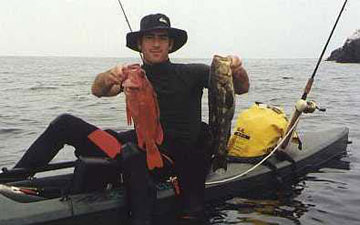
Kayak angler, Trout Traubman.
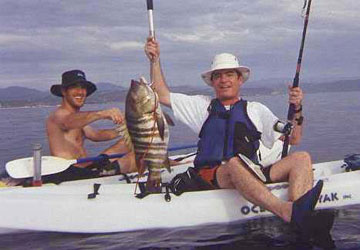
Here's a nice pargo that I gaffed for client, Tom Sweeney, near Rancho Leonero. That was a spring trip when there weren't a ton of yellowfin, but LOTS of other species such as dorado, pargo, sierra, cabrilla, black skipjack tuna, snapper, jack crevalle, etc.

This was a spring day last year. I knew there were white seabass biting and Pete Gray of the Let's Talk Hookup radio show had expressed some interest in "getting a little exercise" on the 'yak. We decided to meet up before dawn, and before we knew it we both had nice fish in the hatch. A few days later, Pete went back to the spot and landed the 50+ pounder and I headed up to Malibu and landed one that went about 40 pounds (you can see that fish with my feature article in the March issue of South Coast Sportfishing Magazine). What a spring it was! I caught mine on fresh-dead squid and Pete got his fly-lining a live mackerel.

Here's a nice specimen photo of a bullseye pufferfish, caught by Peter Langstraat, on cut bait from the beach, at Punta Colorada, October 1998, 12 pound line, length 16 inches. Note bullseye pattern on back.
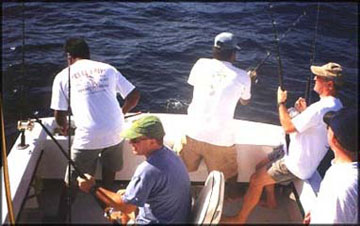
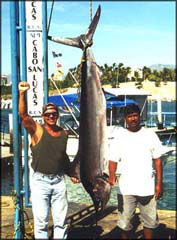
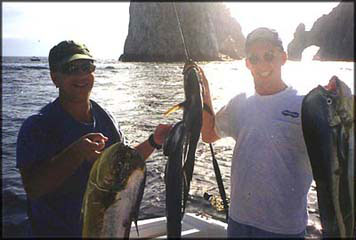
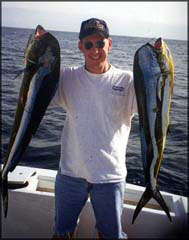
Real Easy Sportfishing anglers from Louisiana this week included Stephen Hebert John Frusha, Glenn Schwartzberg, James McNeil, and Julius Manuel, shown here aboard the El Chilito.
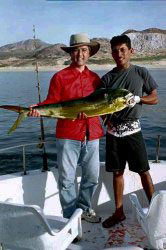
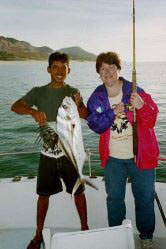
Jeff Klassen's clients found winter action at Cabo San Lucas this week. Check Jeff's announcement in this report of his tournament in July.
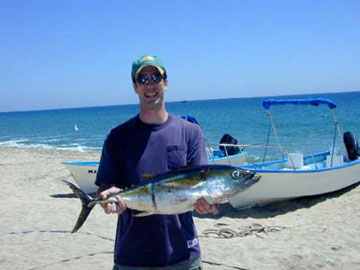
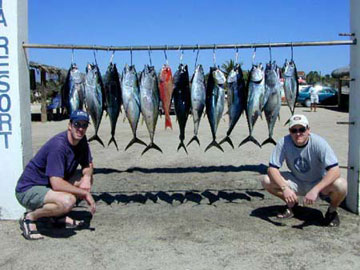
These Gordo Banks Pangas anglers had a fantastic day of fishing this week. Using light tackle and live sardinas for bait they had accounted for this catch of yellowfin tuna by 9:30 a.m. Bill Faulkner was on spring break from Chicago and choose the right day to go fishing. In upper photo, he his holding up a 20 pound class yellowfin with the Sea of Cortez in the background. Below, Faulkner is pictured with his partner and their overall catch, they also called it an early day and were back on the beach 10:30 a.m. Hey, that's pretty decent for March!
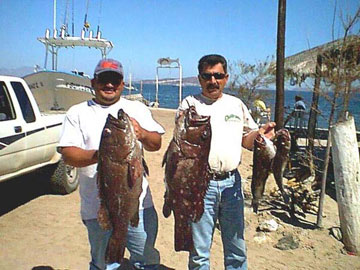

EMAILED (!) from the good doctor Abraham of L.A. Bay are these great photos of Igor and Guillermo with a nice pair of baquetas, and also a specimen photo for our Fish I.D. Page. Thanks, Doc!
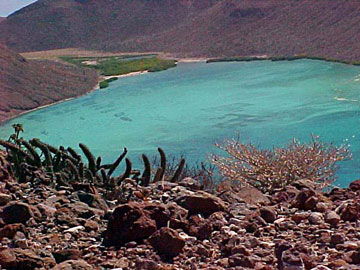
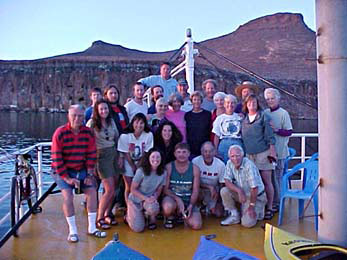
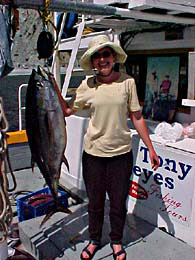
San Felipe's Tony Reyes Fishing Tours started off the 2001 season with two trips to the beautiful La Paz area at the opposite end of the Sea of Cortez. Nothing better than that!
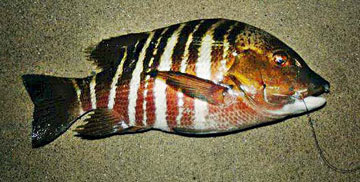
From Dutch angler Peter Langstraat, this beautiful photo showing the fighting colors of a barred pargo, caught at Punta Colorada from the beach on cut bait, October 1998, weight 12 pounds.
Baja coastal fishing reports and articles.
Ensenada fishing reports and articles.
Puerto Santo Tomas fishing reports and articles.
Erendira fishing reports and articles.
San Quintin fishing reports and articles.
Magdalena Bay fishing reports and articles.
Cabo San Lucas fishing reports and articles.
San Jose del Cabo (Los Cabos) fishing reports and articles.
East Cape fishing reports and articles.
La Paz fishing reports and articles.
Loreto fishing reports and articles.
Mulege fishing reports and articles.
Santa Rosalia fishing reports and articles.
Bahia de los Angeles (L.A. Bay) fishing reports and articles.
San Felipe fishing reports and articles.
Rocky Point (Puerto Penasco) fishing reports and articles.
San Carlos (Sonora) fishing reports and articles .
Mazatlan fishing reports and articles .
Puerto Vallarta fishing reports and articles.
Ixtapa Zihuatanejo fishing reports and articles.
Huatulco fishing reports and articles.
Cancun fishing reports and articles.
Mexico coastal fishing reports and articles.
Mexico Fishing Home Page < Mexico Fishing News Archives < Fishing Report
Copyright ©

